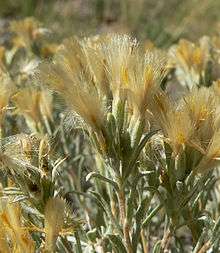Tetradymia canescens
| Tetradymia canescens | |
|---|---|
 | |
| Scientific classification | |
| Kingdom: | Plantae |
| (unranked): | Angiosperms |
| (unranked): | Eudicots |
| (unranked): | Asterids |
| Order: | Asterales |
| Family: | Asteraceae |
| Tribe: | Senecioneae |
| Genus: | Tetradymia |
| Species: | T. canescens |
| Binomial name | |
| Tetradymia canescens DC. | |
Tetradymia argyraea is a species of flowering plant in the aster family known by the common names spineless horsebrush[1] and gray horsebrush. It is native to western North America from British Columbia to California to New Mexico, where it grows in sagebrush, woodlands, forest, scrubby open plains, and other habitat. It is a bushy shrub growing to 60 to 80 centimeters in maximum height with multibranched woody or semi-woody stems that grow from taproots. It is coated in woolly fibers with hairless strips at intervals along the branches. It has no spines. The lance-shaped leaves are no more than 4 centimeters long and woolly or silver-haired in texture. Longer-lived leaves are alternately arranged along the stem and smaller, shorter-lived leaves occur in clusters near the axils of the primary leaves. The inflorescence bears usually three to six flower heads which are each enveloped in four thick phyllaries coated in white woolly hairs. Each head contains four tubular flowers in shades of pale to bright yellow, each measuring up to 1.5 centimeters long. Flowers are produced in summer. The fruit is an achene which may be up to 1.5 centimeters long including its long pappus of bristles.
The shrub is wildfire-resistant, resprouting vigorously and increasing in herbage and seed production in seasons following a fire.[2] Fire suppression efforts decrease the abundance of the shrub and frequent burns increase it.[2]
The shrub is toxic to sheep, causing photosensitivity, bad wool quality, abortion, and death due to the presence of furanoeremophilanes.[2] It causes a swelling of the head known as bighead disease.[2][3]
Native American groups used this plant for a number of medicinal purposes, including protection from ghosts and witches.[4]
| Wikimedia Commons has media related to Tetradymia canescens. |
References
- ↑ "Tetradymia canescens". Natural Resources Conservation Service PLANTS Database. USDA. Retrieved 9 December 2015.
- 1 2 3 4 US Forest Service Fire Ecology
- ↑ Poisonous Plants by Toxic Syndrome. USDA ARS.
- ↑ Ethnobotany